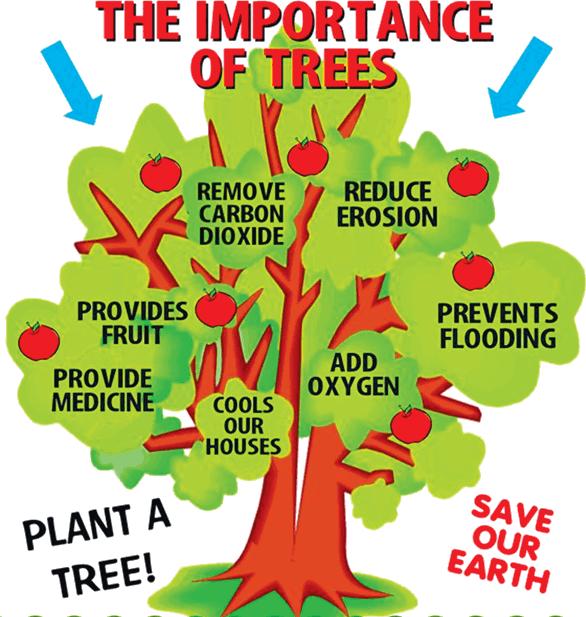
3 minute read
What's Up? Georgian Bay - September 2023
Trees’ Significance for the Environment Human Health and Climate
Amidst urban paving, the rapid growth and developments, the TREE stands as a symbol of life and resilience. Beyond its aesthetic appeal, trees play an indispensable role in shaping our environment, fostering human well-being, and combating the challenges posed by a changing climate. This dynamic relationship between trees, the environment, human health, and climate is a vital triad that merits our attention and stewardship.
1. ENVIRONMENTAL GUARDIANS:
Trees serve as guardians of our environment by performing numerous ecosystem services. Through the process of photosynthesis, trees absorb carbon dioxide, storing it in their trunks, branches, and leaves, helping to mitigate the effects of global warming. Additionally, trees act as natural air purifiers by filtering pollutants, such as nitrogen oxides, sulfur dioxide, and particulate matter, thus improving air quality and reducing respiratory ailments.

Forests are vital habitats for an array of flora and fauna. They foster biodiversity, providing homes and sustenance for countless species. These ecosystems act as complex interconnected webs where every species plays a role in maintaining the balance of the ecosystem. Furthermore, trees help prevent soil erosion, conserve water, and support natural hydrological cycles by capturing rainwater and releasing it gradually, reducing the risk of flooding.
2. NURTURING HUMAN HEALTH:
A simple walk in a forest or a stroll through a tree-lined avenue has profound effects on human health. The concept of “forest bathing” – spending time in wooded areas – has gained recognition for its stress-reducing and mood-enhancing benefits. Phytoncides, natural compounds emitted by trees, have been shown to lower stress hormones, boost the immune system, and alleviate anxiety and depression.
Trees also offer a valuable respite from the sweltering heat of urban environments. Their shade reduces the “urban heat island” effect, where cities experience higher temperatures due to human activities and a lack of green cover. Consequently, this cooling effect reduces energy consumption by decreasing the demand for air conditioning, leading to lower greenhouse gas emissions.
3. CLIMATE WARRIORS:
In an era of mounting concern over climate change, trees emerge as steadfast warriors in the battle against global warming. Their ability to sequester carbon dioxide, a major contributor to the greenhouse effect, is a pivotal element of climate change mitigation strategy. Reforestation and afforestation initiatives are being pursued globally to restore degraded landscapes and create carbon sinks, aiding in the fight against climate change.
Ontario lost most of its ash trees this last decade and now the Oak Wilt, a new disease that can kill red oaks in a few weeks, has been detected in our region for the first time, endangering 8% of Simcoe County and Georgian Bay tree canopy. The loss of trees not only releases stored carbon but also disrupts ecosystems and exacerbates climate change. Thus, preserving existing forests and implementing sustainable land-use practices are essential steps in maintaining the equilibrium of the climate.
In summary, trees are essential components of our environment, contributors to human health, and critical players in the battle to stabilize our climate. Recognizing their significance prompts us to take action, whether it’s planting a tree in our backyard, supporting reforestation projects, or advocating for sustainable land management policies.
Engage with Wasaga Beach Climate Action Team wasagabeachclimateaction.com
info@wasagabeachclimateaction.com
Submitted by Gerard Dusastre


